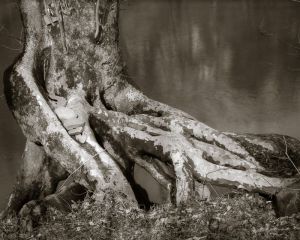There is deception in art, it’s a given. Even photographic art is never an accurate record of reality, even though some of us accept it as such.
But in the case of art, deception is not evil; quite the contrary. Accepting the deception leads us to ask questions, which (eventually) may lead us to a story worth remembering. And that’s a good thing.
More than any other medium of visual art, photographs can objectively inform us. That is, they represent an actual experience, a real moment in time involving real subjects, that paintings and other forms of visual art simply can not.
 Not all photographs inform us. Some styles of photography create such obvious deceptions that the first question we ask is “..how did the photographer do that?” The deception is too obvious to be believed. In fact, informing us is not the purpose of such photographs, so they don’t fit within this discussion. It’s sometimes fun to see how photographers ‘photoshop’ natural subjects (like the “multicolored” Giant Squirrel of India) to create internet sensations… yea,… right.
Not all photographs inform us. Some styles of photography create such obvious deceptions that the first question we ask is “..how did the photographer do that?” The deception is too obvious to be believed. In fact, informing us is not the purpose of such photographs, so they don’t fit within this discussion. It’s sometimes fun to see how photographers ‘photoshop’ natural subjects (like the “multicolored” Giant Squirrel of India) to create internet sensations… yea,… right.
But real photographs, photographs that represent actual objects and the relationships among them, can indeed inform us. Further, they can also evoke stories of real characters and help us develop our own set of personal experiences. Example: Most of us “know” the Golden Gate Bridge, even if we’ve never been to San Francisco.
Still, if you only know the Golden Gate Bridge (or any subject for that matter) through photographs, there’s still plenty you don’t know about it: its actual size/scale, its actual color, its movements, or the actual texture of its painted steel. What you know is incomplete and therefore deceptive.
When confronted with incomplete information, our brains automatically kick into an analytical mode to try to understand the missing pieces. You can’t help it. This is what our brains do naturally, and the more curious one is, the more the brain will question, and eventually fill in the gaps with imaginary information– deceptive information. This phenomenon is the essence of deception in art.
I had an experience this past week that made me think about how important this whole idea of photographic deception is to our enjoyment of photographic art. I want to share it with you.
My experience relates to a photograph of an old sycamore tree along a local creek that I took a couple years ago. “Gran’s Lap” is a straight photograph (albeit an expressive photograph). It clearly shows how she’s suffered from many years of erosion as the spring floods repeatedly wash over her roots. And yet, she still clings on and is thriving. That’s one story, at least my story. Yours may be different.
Before reading on, try to develop in your own mind some sense of the scale of the tree and her bared roots. You likely have no preconceived idea of her actual size, you only have what is framed. There are no wrong or right answers, only what your imagination will lead you to conclude. The title I’ve given you may even bias your imagination, who knows?

Picture yourself sitting down on Gran’s Lap for a quick rest along your hike. (I’ll wait).
So, now that you’re there, is the ‘lap’ big enough for your toosh without falling into the creek? Or is there plenty of room to share?
Over the months since I took this picture, my own memory recalls that Gran’s Lap was just big enough for me to sit comfortably and enjoy the sounds of the creek. Oh, I should tell you that I’m not a very big guy, because what I say next might lead you to think I’m gargantuan.
This weekend, warming weather encouraged me to take my 7 year old grandson James on a hike along the creek. We visited the old sycamore. I’m not sure why, but when seeing this tree this weekend, I was amazed how large it was. In my memory–probably biased by the photograph I took–it was much smaller. To give you an idea, here’s the same tree with James sitting on it, as shot with my iPhone.

My surprise by the actual size of ‘Gran’s Lap’ got me thinking how photographs can be very deceptive to our eyes. Even so called “straight” photographs can’t be believed.
All photographs are deceptive to an extent, aren’t they? There is always some important context missing, because photographs can’t possibly include everything our eyes see as they sweep across the entire field of view and as our brains interpret scale, depth, color, and movement to give us the most complete picture of everything we see.
Photographs can inform us only to a certain extent. Often they only give us enough information to make us question. And the questioning starts because photographs (especially good photographs) first and foremost deceive us, and make us ask “what is this photograph about?” Then our imaginations take over to fill in the answers, and the next thing you know, there’s a story that emerges.
Not every photograph you see will cause you to stop and question what the photograph is about. But sometimes, the subjects or compositions or colors or textures that a photograph may show you is only the start to your enjoying it. When you see such photographs, let your imagination take over and explore the deception, and you’ll become the wiser for it!
What do you think about deception in art? Leave a comment below, I’d love to hear your thoughts.
J. Riley Stewart
April, 2019
